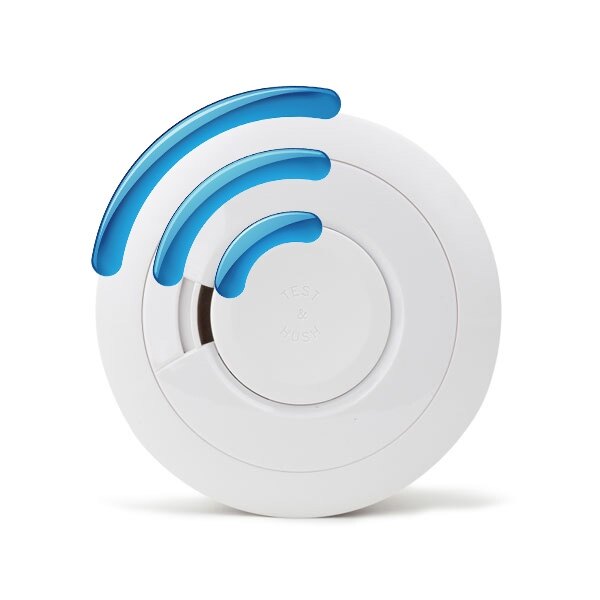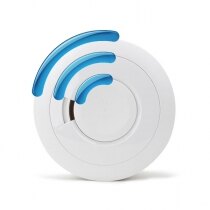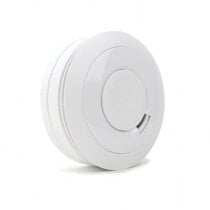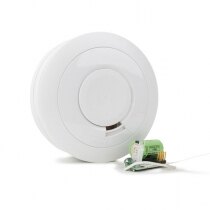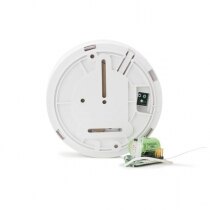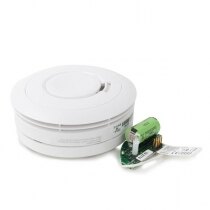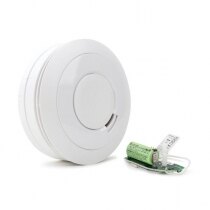Fire & Safety Solutions
CALL OUR TEAM NOW 0800 612 6537
Also FREE from UK mobiles
Quick Delivery
From £3.19 inc VAT
Secure Payments
with our fast checkout
Online Support
Contact Us Now
30 Day Accounts
for Public Sector
5 Star Customer Feedback
10 Year Longlife Battery Radio-Interlinked Smoke Alarm - Aico Ei650RF
How to test your smoke and heat alarms - 00:33
Self-adhesive sticker pads for smoke and heat alarms - 00:58
Videos
Product Overview
Interlink
Technical Data
FAQs (8)
The Ei650RF optical smoke alarm features a 10 year sealed lithium battery designed to last the full lifetime of the alarm, while its built-in RadioLINK+ module allows wireless interlinking with other Aico and Ei Electronics devices in the property to provide maximum protection with minimal effort during installation. Suitable for Grade F installations, this radio-interlink optical smoke alarm is ideal for hallways, bedrooms, and living rooms.
- Battery: Built-in, lasts the lifetime of your alarm
- Warranty: 5 year warranty
- Easy to install with a twist-on base design
- RadioLINK+ wireless module included – pre-installed in the alarm ready to use
- Optional adhesive pad can be added before checkout
- Red LED status indicator – flashes every 40 seconds during normal operation
- Blue LED indicator for RadioLINK+ module status
- Suitable for installations complying to BS 5839-6: 2019 Grade F1
- Screws and fixings supplied with the alarm
- CE Marked and VdS approved to 14604: 2005
- This alarm is also suitable for the updated 2022 Scottish legislation for fire alarms in homes
The table below shows all the units that can interlink with the Ei605RF / Ei650RF.
Smoke and Heat Alarms
|
Model Number
|
Type of Unit
|
Type of Interlink
|
| Ei3014RF | Mains Powered Heat Alarm - Sealed Lithium | Radio Interlink |
| Ei3016RF | Mains Powered Optical Smoke Alarm - Sealed Lithium | Radio Interlink |
| Ei3024RF | Mains Powered Optical & Heat Alarm - Sealed Lithium | Radio Interlink |
| Ei3028RF | Mains Powered Heat & Carbon Monoxide Alarm - Sealed Lithium | Radio Interlink |
| Ei2110eRF | Mains Powered Multi Sensor Smoke & Heat Alarm - Sealed Lithium | Radio Interlink |
| Ei161eRF | Mains Powered Ionisation Smoke Alarm - Sealed Lithium | Radio Interlink |
| Ei164eRF | Mains Powered Heat Alarm - Sealed Lithium | Radio Interlink |
| Ei166eRF | Mains Powered Optical Smoke Alarm - Sealed Lithium | Radio Interlink |
| Ei168RC/141RC | Mains Powered Ionisation Alarm - 9V Alkaline | Radio Interlink |
| Ei168RC/144RC | Mains Powered Heat Alarm - 9V Alkaline | Radio Interlink |
| Ei168RC/146RC | Mains Powered Optical Smoke Alarm - 9V Alkaline | Radio Interlink |
| Ei3100RF | Battery Powered Ionisation Smoke Alarm - 9V Alkaline | Radio Interlink |
| Ei3103RF | Battery Powered Heat Alarm - 9V Alkaline | Radio Interlink |
| Ei3105RF | Battery Powered Optical Smoke Alarm - 9V Alkaline | Radio Interlink |
| Ei603RF | Battery Powered Heat Alarm - Sealed Lithium | Radio Interlink |
| Ei650RF | Battery Powered Optical Smoke Alarm - Sealed Lithium | Radio Interlink |
Carbon Monoxide Alarms
|
Model Number
|
Type of unit
|
Type of interlink
|
| Ei3018RF | Mains Powered Carbon Monoxide Alarm - Sealed Lithium | Radio Interlink |
| Ei3028RF | Mains Powered Heat & Carbon Monoxide Alarm - Sealed Lithium | Radio Interlink |
| Ei262 | Mains Powered Carbon Monoxide Alarm - Sealed Lithium | Radio Interlink |
| Ei208WRF | Battery Powered Carbon Monoxide Detector - Sealed Lithium | Radio Iinterlink |
Ancillary Products
|
Model Number
|
Type of unit
|
Type of interlink
|
| Ei170RF | Mains Powered Strobe and Vibration Pad for the Hearing Impaired - Sealed Lithium | Radio Interlink |
| Ei450 | Battery Powered Fire and CO Alarm Controller - Sealed Lithium | Radio Interlink |
| Ei411H | Battery Powered Locate, Silence & Test Control Switch - Sealed Lithium | Radio Interlink |
| Ei407 | Battery Powered Manual Call Point - Sealed Lithium | Radio Interlink |
| Ei410TRF | Battery Powered Test Remote - Sealed Lithium | Radio Interlink (Ei3100RF Series) |
| Ei428 | Mains Powered 5A Relay Module | Radio Interlink |
| Y03 | Mains Powered Multi Frequency Sounder | Hardwire Interlink (via relay) |
| SAB300C | Mains Powered Flashing Xenon Strobe (Clear) | Hardwire Interlink (via relay) |
| SAB300R | Mains Powered Flashing Xenon Strobe (Red) | Hardwire Interlink (via relay) |
Wiring Explained
Mains powered Ei Electronics smoke and heat alarms require a 230V AC power supply and up to 12 alarms can be hardwire interlinked in one system.
To obtain a mains power supply, each alarm can be connected to the nearest lighting circuit using 2 core and earth cable with a separate, dedicated interlink cable connecting alarms where applicable. However, if possible it is recommended that any alarms connected via interlink cable are all powered from a dedicated circuit from the distribution board using 3 core and earth cable for safety during maintenance, as the interlink cable will carry power from live alarms on other power circuits. Please see the diagram below:-
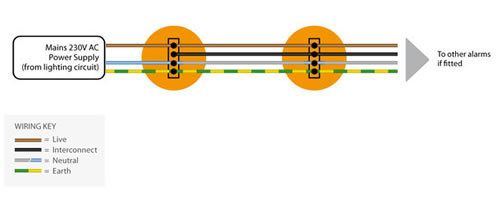
| Product Code | EI650RF |
|---|---|
| Alternative Product Codes | EI650RF, EI650, EI605, EI605TYC, EI605TYCRF, EI650IRF |
| Brand | EI Electronics |
| Battery Type | 10 Year Sealed Lithium |
| Dimensions (HxDia) | 50 x 115mm |
| Operating Temperature | Operating: 0°C to +40°C Storage: 0°C to +35°C |
| Relative Humidity | 15% to 95% |
| Sound Output | 85dB |
| Warranty | 5 Years |
| Weight | 0.26kg |
| Product Datasheets |
Q. How can we test the alarm to make sure it is working?
A.
The manufacturer's recommendation is to test the alarm by pressing the test button. This will simulate a heat input at the heat sensor. You can also test it with a hair dryer but make sure that the hairdryer is kept away at a suitable distance from the alarm. Do not attempt to test the alarm by using open fire or excessive heat as this may damage the unit.
Q. Is it possible to have a heat alarm mains powered radio interlinking alarm interconnect with battery powered radio-interlinked alarms?
A.
Yes this entirely possible. The Ei140 series with RF base is mains powered and these are compatible to interlink with the battery operated Ei3100 series. Please view the interconnection overview on either of these alarms for further details.
Q. Do the Ei600 series alarms need 230v or do they just use battery?
A.
The Ei600 series of radio-interlinked alarms are completely battery operated. This means that they do not need to be wired up to the mains circuit. On the website, we offer the Ei600 series with a standard 9v battery or with a 10 year lithium longlife battery. The standard 9V batteries last approximately 12-18 months depending on how often the detectors are tested. The lithium battery units are sealed and last 10 years i.e. the full lifespan of the detector.
Q. Where more than one radio-interlinked battery operated smoke alarm is installed, if the battery in one alarm failed would the other alarms be affected?
A.
If one alarm was to malfunction the other units would not be affected, if it was due to alarm failure. If the fault was with the radio-interlinking signal, then all alarms that are in the chain after the faulty alarm would be affected and they would not go off.
Q. Do the radio interlinked units give out a constant signal all the time and does this decrease the battery life more than a non-interlinked alarm?
A.
Show All Yes, radio interlinked alarms are periodically sending and receiving signals from other units in the network and therefore the life of the battery is reduced. Units with alkaline batteries should have the batteries are changed annually [unless they are fitted with a sealed 10 year battery as eg in the Ei600RF series].
Pricing & Availability
| Model | Stock | Price |
|---|---|---|
| Product Code: EI650RF |
Stock Level:
More than 20 in stock Expected dispatch: 29th Jul
|
Price:
£87.23 inc VAT £72.69 ex VAT |
Approved Partner
Delivery Options
The following delivery options are available on this product.
Customer Reviews
7 customers have given this product an overall rating of 4.7 out of 5
Reviews by real customers
All of our product reviews are written by real customers that have purchased this product from us and are published without modification.Rating: 4 / 5 Stars
Reviewed by: C C
Ok Good
Published on: 2nd July 2023
Rating: 5 / 5 Stars
Reviewed by: R Y
Quality product. First class service.
Published on: 3rd July 2022
Rating: 4 / 5 Stars
Reviewed by: D M
Good quality product
Published on: 28th March 2022
Looking for more information?
If you have any questions or would like more information about this product you can ask one of our specialists.
Direct Telephone
01507 464181





















